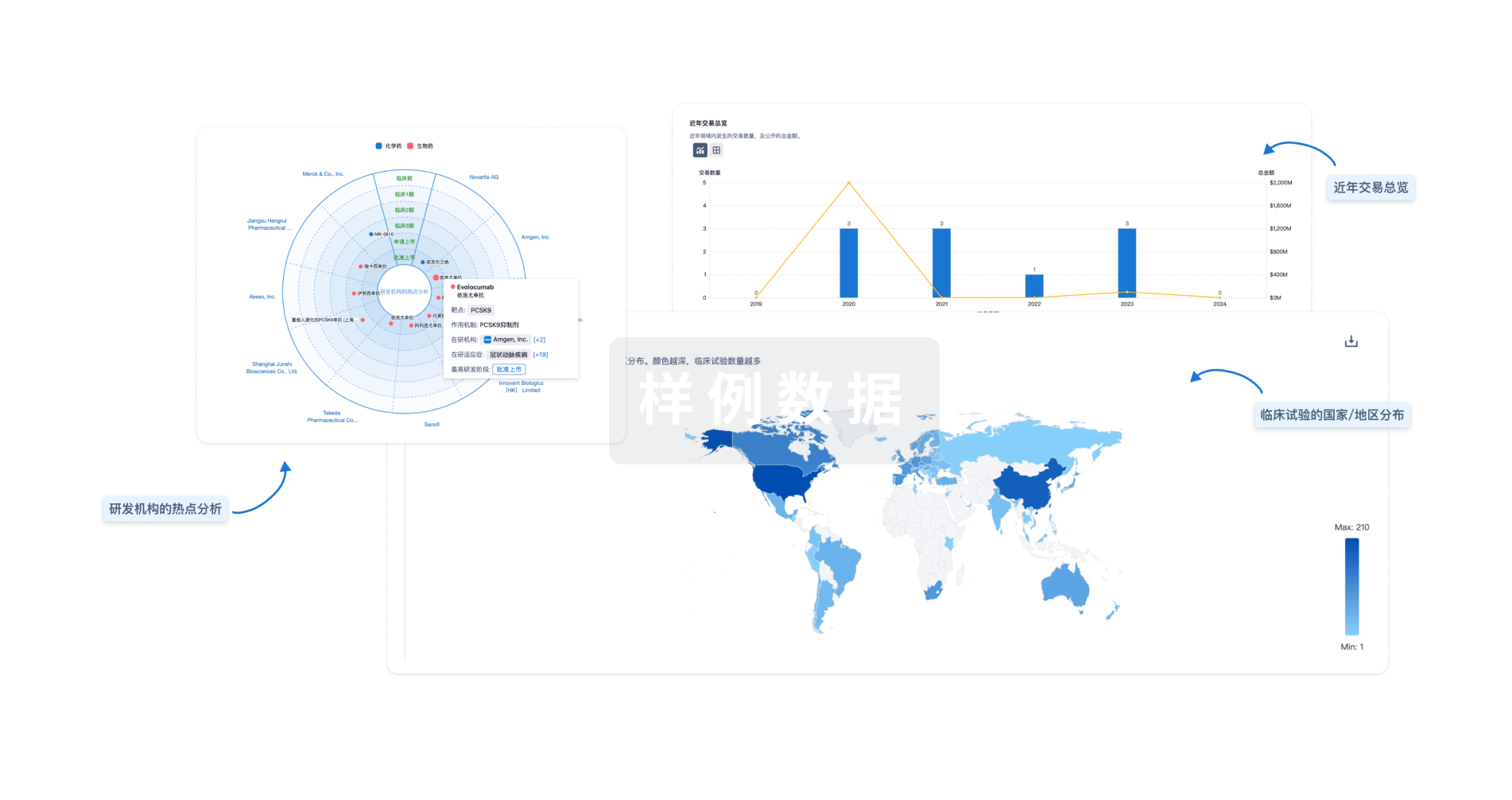预约演示
更新于:2025-05-07
IL-17F x TNF-α
更新于:2025-05-07
关联
1
项与 IL-17F x TNF-α 相关的药物作用机制 IL-17F抑制剂 [+1] |
在研机构- |
原研机构 |
在研适应症- |
非在研适应症 |
最高研发阶段无进展 |
首次获批国家/地区- |
首次获批日期1800-01-20 |
100 项与 IL-17F x TNF-α 相关的临床结果
登录后查看更多信息
100 项与 IL-17F x TNF-α 相关的转化医学
登录后查看更多信息
0 项与 IL-17F x TNF-α 相关的专利(医药)
登录后查看更多信息
344
项与 IL-17F x TNF-α 相关的文献(医药)2025-04-01·Chinese Journal of Natural Medicines
Andrographolide sulfonate alleviates rheumatoid arthritis by inhibiting glycolysis-mediated activation of PI3K/AKT to restrain Th17 cell differentiation
Article
作者: Zeng, Xi ; Wu, Xiaoqian ; Song, Lijuan ; Wei, Zhifeng ; Li, Ze ; Yuan, Xiaomei ; Guan, Yi ; Xie, Ning ; Yang, Ling ; Jiang, Chunhong ; Wang, Jia
2025-04-01·Current Molecular Medicine
CD4+ T-cell Subsets and Cytokine Signature in Pemphigus Foliaceus Clinical Stratification beyond the th1/Th2 Paradigm
Article
作者: Raouia, Fakhfakh ; Olfa, Abida ; Sawsan, Feki ; Hamida, Turki ; Mariem, Ben Jmaa ; Meriam, Mseddi ; Emna, Bahloul ; Mohany, Mohamed ; Sellami, Khadija ; Milošević, Marija ; Nesrine, Elloumi ; Hatem, Masmoudi
2025-03-01·Experimental Dermatology
Hyperuricemia Exacerbates Psoriatic Inflammation by Inducing M1 Macrophage Activation and Th1 Cell Differentiation
Article
作者: Yang, Bin ; Xu, Ying‐Ping ; Zhang, Yan ; He, Shuang ; Wu, Xiao‐Yan ; Wei, Shu‐Yi ; Sun, Yu‐Zhe
55
项与 IL-17F x TNF-α 相关的新闻(医药)2025-04-30
·小药说药
-01-引言炎症性肠病(IBD)由溃疡性结肠炎(UC)和克罗恩病(CD)组成,全球约有600万至800万人受到影响。作为一种慢性、进行性和复发性的肠道疾病,IBD严重影响患者的生活质量和日常生活,增加医疗负担。虽然目前普遍认为IBD是由遗传易感个体对微生物的异常免疫反应引起的,但其确切的发病机制在很大程度上尚不清楚。目前可用的IBD治疗包括非靶向治疗(如氨基水杨酸、糖皮质激素和免疫调节剂)和靶向治疗(如抗TNF、抗IL-12/IL-23和抗α4β7整合素)。虽然生物靶向疗法对许多患者有效,但依然有高达30%的患者对初始治疗没有反应,高达50%的患者随着时间的推移反应消失。因此,深刻理解肠免疫系统的运行机制和IBD的免疫发病机制,将有助于我们开发针对IBD的免疫治疗药物,并为IBD提供了新的免疫治疗手段。-02-一、肠道免疫系统肠道微生物群人类肠道微生物群由数万亿种微生物组成,包括真菌、单细胞动物、病毒、古生菌和占绝大多数的细菌。肠道微生物群通过调节固有免疫系统的激活,影响宿主能量代谢、免疫稳态和成熟,以及维持粘膜完整性,在IBD的发病机制中发挥着至关重要的作用。越来越多的证据表明IBD患者肠道微生物群的组成发生了改变。例如,大肠杆菌作为病原菌在肠道中增加,具有在巨噬细胞中生存和复制的能力,并诱导IBD中TNF-α的分泌和炎症反应。此外,作为益生菌的prausnitzii粪杆菌可以刺激DC分泌抗炎细胞因子IL-10,并抑制肠道中IL-12和INF-γ的产生,而IBD患者的肠道中这些细胞因子显著减少。此外,IBD患者肠道微生物群的代谢产物也会发生改变,例如胆汁酸代谢中断、色氨酸代谢水平降低、SCFA减少以及烟酸、牛磺酸和酰基卡尼汀水平升高。这些代谢物在肠道炎症过程中的丢失可能是IBD发病的驱动力。肠上皮细胞(IECs)肠上皮是人体最大的粘膜表面,充当管腔内容物和潜在免疫系统之间的物理和生化屏障。它由单层不同亚型的特异性内皮细胞组成,主要包括柱状上皮、杯状细胞和Paneth细胞。杯状细胞作为肠上皮的分泌细胞,可以在肠粘膜的管腔表面分泌粘液,粘液层提供了第一道防线。Paneth细胞是一种特殊的含有颗粒的细胞,存在于小肠的上皮隐窝中,在先天性肠道防御和保护附近干细胞中起着至关重要的作用。它们可以产生抗菌肽(AMP),如α-防御素、溶菌酶C、磷脂酶和C型凝集素等,这些抗菌肽可以对抗侵入的管腔病原体。已经证明,AMP在CD患者中存在缺陷。肠上皮的另一个重要组成部分是顶端连接复合体,由紧密连接(TJ)、粘附连接(AJ)和桥粒组成,紧密密封肠上皮细胞,以防止病原体进入,并调节对水、离子和营养素的渗透性。编码TJ的基因突变和TJ功能障碍已被阐明为IBD的关键致病因素。肠道免疫细胞肠道免疫细胞可分为天然免疫细胞和适应性免疫细胞,这两种细胞对IBD的免疫反应都有很大贡献。固有免疫细胞,如巨噬细胞、树突状细胞(DC)、中性粒细胞、自然杀伤(NK)细胞和固有淋巴细胞(ILC),相互作用并产生细胞因子、趋化因子和抗菌素,以触发炎症,导致吞噬、抗原提呈和适应性免疫系统的激活。巨噬细胞、树突状细胞、中性粒细胞、NKT细胞和ILC构成粘膜固有免疫系统的第一道防线。这些固有免疫系统的免疫细胞通过病原体相关分子模式(PAMP),导致多种信号通路的激活,并产生促炎细胞因子、趋化因子和抗菌肽。与天然免疫细胞相比,适应性免疫细胞具有高度的特异性和免疫记忆能力,它们相互补充,消除入侵病原体。适应性免疫反应的关键参与者是T细胞,在肠道相关淋巴组织(GALT)或肠系膜淋巴结中的抗原刺激下,原始T细胞被激活并分化为不同的亚群,在趋化因子受体(如CCR9和CCR10)和整合素等细胞粘附分子作用下迁移到肠道的炎症部位。如今,许多针对这些受体的药物已成功用于临床实践,以阻止T细胞向肠道迁移,以预防IBD患者的炎症。-03- 二、IBD的免疫学发病机制IL-22和IL-6IL-22是一种多效性细胞因子,由Th22、Th17和Th1细胞分泌,激活STAT3以促进肠组织修复并抑制肠道病原体。在IBD中,IL-22受微生物群的信号诱导在小肠中广泛表达。此外,IL-22还促进IBD易感基因如fut2、sec1、bcl2115和PTPN22的表达。IL-6主要由固有层中的巨噬细胞和树突状细胞产生。研究发现,CD患者血清和肠道中IL-6水平升高,并与临床疾病活动、复发频率和炎症严重程度相关。与受体结合后,IL-6激活gp130阳性T细胞,导致STAT-3信号转导和转录激活,随后激活抗凋亡基因Bcl-2和Bcl-xl的转录。目前,人源化抗IL-6R单克隆抗体tocilizumab已经用于治疗IBD。IL-12/IL-23由树突状细胞产生的IL-12和IL-23均属于IL-12家族,在慢性炎症性疾病的发病机制中发挥重要作用。在几种结肠炎模型中,致病性T细胞反应由IL-12和IL-23驱动。IL-12可以促进原始CD4+T细胞分化为产生IFN-γ的Th1细胞,并促进NK细胞、NKT细胞和细胞毒性T细胞的增殖和效应功能。IL-23通过加强和影响Th17细胞反应来发挥其生物学功能,同时它还拮抗抗炎Foxp3+Treg细胞反应从而促进肠道炎症。IL-17IL-17细胞因子,包括IL-17A和IL-17F,也在IBD的发病机制中发挥重要作用。全基因组关联研究(GWAS)已确定了许多与Th17相关的IBD易感基因,包括JAK2、STAT3、IL-23R、IL-12B和CCR6。临床研究发现,与健康对照组相比,IBD患者的肠粘膜和固有层中含有更高水平的Th17细胞、IL-17和IL-23。在小鼠模型中,IL-17A和IL-17F的缺陷显示对结肠炎具有保护作用。Il-10IL-10是抑制免疫系统促炎反应的最重要细胞因子,可由大量不同类型的细胞产生,包括Treg、巨噬细胞、树突状细胞等。在IBD患者的早期发病过程中,IL-10R亚单位基因的突变与肠道炎症免疫反应有关。事实上,IL-10和IL-10R缺陷小鼠都可以发生自发性结肠炎。此外,Treg细胞中c-MAF失活也会导致IL-10产生功能障碍,从而发展为自发性结肠炎。IL-1β家族细胞因子IL-1β是一种由巨噬细胞分泌的促炎细胞因子,与其他促炎细胞因子(如TNF-α和IL-6)协同作用,以诱导IBD炎症。研究发现,IL-10缺陷小鼠在自发性结肠炎发病前IL-1β分泌增加。此外,IL-1β和IL-18信号的遗传缺陷或抑制可缓解实验性结肠炎。TNF和TNF样配体1A(TL1A)TNF被认为是IBD发病机制中的促炎细胞因子,可刺激急性期时的反应,促进IL-1和IL-6的分泌,增加粘附分子的表达。研究发现,活动期IBD患者的血液、上皮组织和粪便中TNF-α显著升高,其水平与CD患者的临床疾病活动性相关。通过抗TNF-α单克隆抗体阻断TNF-α信号已成为中重度难治性IBD患者的重要治疗方法。TNF家族成员TL1A也被发现是肠道炎症的关键介质,在IBD患者中水平也升高。TL1A主要通过结合死亡受体3(DR3)发挥其功能,TL1A还可以协同促进IL-4、IL-12和IL-23的产生,并通过Th1、Th2和Th17细胞增加DR3的表达,以促进炎症。免疫细胞迁移免疫细胞迁移到肠道以启动和维持免疫反应是IBD的关键发病机制,其中T细胞迁移是最重要的一个。免疫细胞迁移的完整过程包括栓系、滚动、激活、粘附和外渗,涉及各种整合素、选择素、趋化因子及其配体或受体,例如促进迁移到小肠的整合素α4β7、α4β1、β2整合素和CCR9。针对免疫细胞迁移不同阶段的多种治疗方法已经应用于临床。-04-三、IBD的免疫治疗目前,7种生物制剂已被美国食品和药物管理局(FDA)正式批准用于治疗IBD,许多治疗IBD的创新候选药物的临床试验也正在进行中。靶向TNF-α抗TNF的抗体已广泛使用约25年。目前,四种TNF-α抑制剂已被批准用于临床,包括infliximab、adalimumab、golimumab和certolizumab pegol。infliximab可诱导粘膜溃疡愈合,这是第一种被批准用于CD肛周瘘的治疗方法,并被证明对CD和UC都有效。Adalimumab被证明可诱导CD的粘膜愈合,它对CD和UC以及对infliximab失去反应的CD患者也有效。此外,golimumab和certolizumab pegol也在美国被批准用于治疗UC。虽然抗肿瘤坏死因子治疗显示出临床疗效,但10-30%的IBD患者没有响应,20-40%的患者随着时间的推移失去响应。靶向IL-12/IL-23Ustekinumab是针对IL-12和IL-23的p40亚单位的单克隆抗体,在治疗IBD中显示出积极作用,它是目前FDA批准的唯一一种抗IL-23疗法。另一个靶点是针对IL-23的p19亚单位,也显示出了临床疗效,包括risankizumab、brazikumab、guselkumab和Mirikizumab。然而,这些抗体仍处于临床试验阶段。靶向JAKJanus激酶(JAK)家族包含四种细胞内酪氨酸激酶:JAK1、JAK2、JAK3和非受体酪氨酸蛋白激酶2,它们激活STAT通路并在IBD的发病机制中发挥关键作用。目前,已经评估了10种JAK抑制剂对IBD的临床疗效,而Tofacitinib是唯一具有临床疗效的抑制剂,并被批准用于UC的临床治疗。靶向细胞粘附分子作为T细胞募集和肠道炎症的重要介质,细胞粘附分子是IBD的潜在靶点。例如,抗α4β7整合素抗体vedolizumab和抗a4整合素单克隆抗体natalizumab在治疗IBD方面显示出了很好的疗效,目前已被批准并广泛应用于临床。此外,Etrolizumab(一种选择性结合β7亚单位的单克隆抗体)、abrilumab(一种阻断α4β7整合素的单克隆抗体)和ontamalimab(一种靶向MAdCAM-1的人源化抗体)在临床前数据中也显示出疗效,目前仍在进行临床试验。靶向NLRP3炎症小体NLRP3炎症小体和促炎细胞因子水平升高是IBD的主要病理机制。已经观察到CD患者具有高水平的NLRP3炎症小体。此外,活化的NLRP3炎性小体可促进过量IL-1β的产生,并改变结肠上皮中TJ的表达,从而加速疾病进展。因此,靶向NLRP3炎症小体为IBD治疗提供了一种有前景的策略。-05-结语在过去的几十年里,IBD的免疫学机制取得了很大进展,为IBD的治疗提供了新的策略和新的思路。在未来,特定基因位点的改变可能是IBD很有希望的治疗方法。此外,新型抗体或抑制剂、联合治疗方案和多因子阻断剂也有望打破IBD治疗的瓶颈,为IBD的患者的疾病改善带来福音。参考资料:1.Immunology of Inflammatory Bowel Disease: Molecular Mechanisms and Therapeutics. J Inflamm Res.2022; 15: 1825–1844.
免疫疗法微生物疗法
2025-04-28
关注并星标CPHI制药在线近日,恒瑞的夫那奇珠单抗(Vunakizumab,SHR-1314)在国内获批新适应症,用于常规治疗疗效欠佳的活动性强直性脊柱炎成人患者。这是继斑块状银屑病之后,夫那奇珠单抗在国内获批的第二项适应症。夫那奇珠单抗是恒瑞自主研发的人源化IgG1抗白细胞介素17A(IL-17A)单抗,与IL-17A结合后可抑制下游细胞因子,从而阻断炎症信号传导。同时较低的鼠源成分,也降低了潜在的免疫原性。作为自免赛道的黄金靶点,IL-17的药物研发已呈现白热化状态,而且仍有越来越多的玩家入局该赛道。对于一众后来者来说,如何快速突围? 百亿市场迎来新玩家强直性脊柱炎(AS)是一种慢性炎症性疾病,患者多为逐渐出现腰背部或骶髂部疼痛和/或晨僵。本疾病主要侵犯骶髂关节、脊柱骨突、脊柱旁软组织及外周关节,严重者可发生脊柱畸形和强直。同时这一疾病好发于青壮年人群,发病的高峰年龄在18~35岁。许多患者不仅饱受病痛折磨,结构损伤的不断进展还会导致脊柱功能丧失甚至残疾,严重降低患者的生活质量。据公开数据,2023年国内AS治疗药物全终端(零售、医院、电商)销售额突破120亿元,且需求持续增长。目前,针对强直性脊柱炎的生物制剂有TNF-α抑制剂及IL-17A抗体等。尽管选择较多,但依然存在着进一步提高疗效,扩大早期适应症,降低耐药复发等未被满足的临床需求。国内智翔金泰的重组全人源抗IL-17A单克隆抗体赛立奇单抗(商品名:金立希)于今年1月正式获批强直性脊柱炎适应症,是国内首个获批该适应症的国产IL-17A抑制剂。恒瑞的夫那奇珠单抗在AS治疗领域的表现备受关注。在III期临床研究中,夫那奇珠单抗展现出了优异的数据。与安慰剂相比,夫那奇珠单抗 120 mg 组 16 周的 ASAS 20、ASAS 40、ASAS 5/6 应答率分别为 65.6%、46.3% 和 55.4%,显著优于安慰剂,并持续改善至第 32 周;在第2周时,夫那奇珠单抗 120 mg 组 ASAS 20 应答率就已高于安慰剂(34.0% vs 11.6%,p<0.0001),且较安慰剂大幅改善总背痛 VAS 评分、晨僵及炎症指标等。另外,国内鑫康合生物/丽珠生物的XKH004,是一款同时靶向IL-17A和IL-17F的IgG1型人源化单克隆抗体,通过阻断IL-17A/F与其受体的相互作用而抑制下游炎症信号通路。在治疗AS的Ⅲ期临床研究中,在入组的323例受试者中,经XKH004药物160mg每四周一次(Q4W)治疗的受试者第16周ASAS40应答率显著高于安慰剂组(45.5% XKH004 vs 19.4% PBO;P<0.001);关键次要终点指标第16周ASAS20应答率两组之间也具有显著差异(62.2% XKH004 vs 34.8% PBO;P<0.001);在第16周时其他次要疗效指标,治疗组也均显著优于安慰剂组。目前中国AS患者群体约500万,但诊断率和治疗渗透率分别不足50%和30%,生物制剂的使用比例更低。随着IL-17抑制剂在全球市场的快速崛起,国内需求正加速释放。红海赛道,后来者如何突围? 1993 年,IL-17 首次被科研人员发现。随后的深入研究发现 IL-17 在宿主防御、自身免疫性疾病发病以及肿瘤的发生、进展中发挥着重要作用,因此IL-17的研究逐渐成为医学及免疫学研究的热点。从其作用机制来说,IL-17受体(IL-17R)被3种二聚体形式的IL-17激活,包括IL-17AA、AF和 FF。基于此,IL-17抑制剂开发分化出两种思路:靶向IL-17A或IL-17A/F。目前,国内已经获批上市6款IL-17靶向药物,分别是来自诺华、礼来、协和麒麟、优时比的四款进口产品,以及智翔金泰、恒瑞的两款国产产品。 国内已上市IL-17靶向药物(来自公开资料)除了已上市产品外,国内针对IL-17靶点布局的企业越来越多。在生物类似药方面,仅针对司库奇尤单抗的生物类似药,国内就有百奥泰的BAT2306、石药集团的CMAB015等多款产品,并且已进入Ⅲ期临床阶段。面对这一渐成红海的赛道,后来者要想脱颖而出,大概有三个方向: 1.适应症拓展。除了银屑病、强直性脊柱炎等自免疾病外,IL-17A靶向药还可以在罕见病领域发挥潜力。例如在狼疮性肾炎这一适应症上,智翔金泰的赛立奇单抗,早在2022年5月便向CDE提交了该适应症的临床试验默示许可申请。今年3月,诺华的司库奇尤单抗新适应症获得国家药品监督管理局批准,用于治疗中重度化脓性汗腺炎(反常性痤疮)的成人患者。在我国,化脓性汗腺炎患病率为33.49/10万,被列入国家《第二批罕见病目录》,目前约有50万患者深受困扰。2. 剂型改良。目前IL-17生物制剂大多以注射剂为主,为了提高患者依从性,口服剂型成为药企努力的目标。礼来早在2019年便推进了自研IL-17A口服小分子抑制剂LY3509754,用于银屑病的临床开发,最终折戟于I期临床。但是礼来并未放弃。2023年,礼来以24亿美元的价格收购了DICE Therapeutics,目标便是2款处于临床阶段的IL-17口服小分子抑制剂DC-806(现已被礼来放弃)和DC-853。Protagonist公司正在计划推进口服肽IL-17拮抗剂的开发。丹麦的LEO制药公司则在开发IL-17A口服PPI调节剂(cpd23)。 3.开发双/多靶点药物。MoonLake Immunotherapeutics(被默克收购)开发的Sonelokimab是一款靶向IL-17A / F的纳米三抗药物,同时融合了结合白蛋白的纳米抗体来延长半衰期,由三个VHH结构域组成,可促进sonelokimab在炎症水肿部位的进一步富集。目前Sonelokimab开展了针对银屑病、化脓性汗腺炎和银屑病关节炎的临床试验。IL-17靶点作为自免赛道的热门靶点,早已成为药企兵家必争之地,未来要想在激烈的竞争中脱颖而出,唯有做好差异化布局。参考来源: 1.Yan, K., Li, F., Bi, X., et al. (2024). Efficacy and safety of vunakizumab in moderate-to-severe chronic plaque psoriasis: A randomized, double-blind, placebo-controlled phase 3 trial. Journal of the American Academy of Dermatology. Advance online publication. doi:10.1016/j.jaad.2024.09.031. 2. 智研咨询,《中国强直性脊柱炎治疗药物行业发展趋势:市场竞争加剧,生药物提升市场空间广阔》.3. 相关公司公告 END领取CPHI & PMEC China 2025展会门票来源:CPHI制药在线声明:本文仅代表作者观点,并不代表制药在线立场。本网站内容仅出于传递更多信息之目的。如需转载,请务必注明文章来源和作者。投稿邮箱:Kelly.Xiao@imsinoexpo.com▼更多制药资讯,请关注CPHI制药在线▼点击阅读原文,进入智药研习社~
临床3期申请上市临床结果
2025-03-13
·小药说药
-01-
导读
1989年,Th1和Th2细胞的二分法奠定了T细胞研究的基石。然而,2005年,董晨教授与Casey Weaver团队在《自然·免疫学》上的突破性研究,揭示了第三类T细胞亚群——Th17细胞,其以分泌IL-17为标志,彻底改写了免疫学教科书。这一发现源于对自身免疫性疾病机制的追问:为何阻断Th1/Th2通路后,炎症仍持续存在?
Th17细胞的命名源于其核心产物IL-17,而后续研究进一步明确了其分化路径:IL-6、TGF-β和IL-23等因子协同调控,驱动RORγt转录因子的表达,最终形成具有独特功能的Th17细胞。这一发现不仅解释了传统理论无法覆盖的炎症机制,更为药物研发开辟了新方向。
-02-
IL-17的生物学作用:双刃剑的免疫调控
IL-17家族包括六个成员(IL-17A至IL-17F),它们通过IL-17受体(IL-17 Ra至IL-17 Re)介导其生物学功能。Th17细胞通过分泌IL-17A/F、IL-21、IL-22等细胞因子,构建了复杂的免疫网络。
1. 促炎与免疫防御
激活炎症反应:IL-17通过结合受体IL-17RA/RC,激活NF-κB、MAPK等信号通路,诱导上皮细胞、成纤维细胞等分泌IL-6、TNF-α、趋化因子(如CXCL1、CXCL8),招募中性粒细胞、单核细胞至感染或损伤部位,清除胞外病原体(如细菌、真菌)。
抗微生物屏障:促进上皮细胞分泌抗菌肽(β-防御素、S100蛋白等),增强皮肤、黏膜等物理屏障功能,抵御念珠菌、金黄色葡萄球菌等侵袭。
2. 组织修复与稳态维持
促进上皮再生:通过诱导角质形成细胞增殖和伤口愈合相关因子(如IL-22),加速皮肤、肠道等组织损伤修复。
维持肠道稳态:与IL-22协同调节肠道杯状细胞分泌黏液,保护肠道屏障完整性,防止病原体入侵。
3. 免疫调节与病理损伤
协同其他炎症因子:与TNF-α、IL-1β等协同放大炎症级联反应,在自身免疫病(银屑病、类风湿关节炎)中驱动慢性组织破坏。
介导骨代谢失衡:刺激破骨细胞分化和骨吸收,导致类风湿关节炎的骨侵蚀和银屑病关节炎的关节破坏。
动态可塑性:Th17细胞在慢性炎症中可转化为促炎的Th1样细胞,或分化为调节性Th17(分泌IL-10),影响疾病进展或缓解。
4. 肿瘤微环境调控
双重作用:在部分肿瘤中,IL-17促进血管生成(通过VEGF)和免疫抑制性微环境形成;但在特定情况下(如结肠癌),IL-17也可能增强抗肿瘤免疫应答。
-03-
IL-17在自身免疫疾病中的作用
炎症性皮肤和关节疾病
IL-17在银屑病、银屑病关节炎和强直性脊柱炎的病理学中具有公认的作用。IL-17Ra或其启动子中增强IL-17应答的SNP已被确定为银屑病和强直性脊柱炎的风险因素。在银屑病皮肤病变的真皮中发现TH17细胞,并在识别CD1a呈递的自身脂质抗原后介导小鼠和人类的皮肤炎症。此外,银屑病关节炎患者的滑液中发现具有组织驻留表型的产生IL-17的CD8+T细胞。
一系列靶向IL-23/IL-17途径的治疗已经在临床上得到广泛应用。临床试验表明,靶向IL-12p40(ustekinumab)、IL-17A(secukinumab和ixekizumab)、IL-17A和IL-17F(bimekizumab)、IL-17RA(brodalumab)和IL-23(guselkumab, tildrakizumab和risankizumab)对中重度银屑病的治疗有效。靶向IL-23/IL-17途径的疗法对银屑病关节炎和强直性脊柱炎也有效。
MS和EAE
关于TH17细胞和IL-17在自身免疫疾病中的致病作用的许多初步发现是在多发性硬化症(MS)的EAE小鼠模型中获得的。最近的研究提供了令人信服的证据,证明IL-17是EAE中的关键致病细胞因子,也是MS中的主要药物靶点。
在EAE模型中,由IL-23和IL-1β或IL-18驱动的TH17细胞是介导病理学的关键T细胞群。在EAE早期,共表达αβ和γδTCR的T细胞被招募到中枢神经系统,这些高度活化的T细胞通过提供IL-17而充当炎症反应的初始触发器。
然而,也有人认为IL-17在EAE中不起主要作用。因为,在EAE的复发-缓解模型中,当在疾病诱导时或复发前给予抗IL-17单克隆抗体时,其治疗可减轻疾病,但在疾病高峰时却几乎没有效果。但是,这并不排斥IL-17可以作为MS的重要药物靶点,阻断IL-17通路可能抑制TH17细胞和γδT17细胞的诱导或再激活,这可能是预防MS患者复发的有效方法。
炎症性肠病
活动性溃疡性结肠炎或克罗恩病患者的血清和炎症粘膜中IL-17的表达显著增加。此外,GWAS研究表明,IL23R基因中的非同义SNP与克罗恩病相关。对结肠炎小鼠模型的研究表明,由TH17细胞和/或ILC产生的IL-17在慢性肠道炎症中起着关键作用。
这些研究导致了IL-17和IL-23靶向治疗炎症性肠病(IBD)的临床试验,ustekinumab已被批准用于治疗克罗恩病。然而,在IBD患者中使用secukinumab或brodalumab的临床试验导致了念珠菌感染增强和肠道炎症增加。虽然IL-17和TH17细胞可以引起炎症,从而损害肠道粘膜,但IL-17与IL-22在限制肠道真菌和细菌感染方面也起到保护作用。
其他自身免疫和炎症性疾病
对实验性自身免疫性葡萄膜炎小鼠模型的研究表明,IL-17在病理学中起着关键作用,然而在非感染性葡萄膜炎患者中使用secukinumab的临床试验未达到主要疗效终点。
此外,Th17细胞在I型糖尿病中也具有致病作用,Th17细胞在1型糖尿病患者的血液中扩增,IL-17增强人类胰岛细胞的炎症反应。用抗IL-17单克隆抗体或重组IL-25(抑制Th17细胞)治疗可减轻疾病。抗IL-12p40和抗IL-17单克隆抗体的临床试验正在1型糖尿病病人中进行。
此外,有证据表明IL-17在其他自身免疫性疾病中也发挥作用,如系统性红斑狼疮。
-04-
IL-17靶向药物的开发现状
截至2025年,全球已获批的IL-17靶向药物主要包括以下五类:
司库奇尤单抗(Secukinumab)(诺华):首个获批的IL-17A单抗(2015年),2020年销售额突破40亿美元,覆盖银屑病、银屑病关节炎(PsA)、强直性脊柱炎(AS)及化脓性汗腺炎(HS)。
依奇珠单抗(Ixekizumab)(礼来):2016年获批,优势在于高亲和力结合IL-17A,对难治性银屑病皮损清除率(PASI 100)达44%。
布罗达单抗(Brodalumab)(安进/阿斯利康):靶向IL-17RA受体,阻断IL-17A/F/C/E信号,2017年获批用于银屑病,对重度患者PASI 75应答率达83%。
比美吉珠单抗(Bimekizumab)(优时比):同时中和IL-17A和IL-17F,2022年获批,临床数据显示其对银屑病的PASI 90应答率高达91%。
Netakimab(俄罗斯Biocad):针对IL-17A,在中东欧市场占据一定份额。
国内方面,在研IL-17管线已逾50个,竞争十分激烈。目前就开发进度来看,恒瑞和智翔稳居第一梯队。2020年5月,创响生物以首付款和里程碑付款总计2.25亿美元的价格获得Izokibep在大中华区、韩国等国家和地区的独家开发和商业化权利,以及在日本以外的亚太地区进行临床开发的权利。
-05-
结语:解码免疫,点亮希望产生IL-17的T细胞和先天免疫细胞在对真菌、细菌以及病毒和寄生虫的免疫中起着关键的保护作用,但也可以介导破坏性的感染相关免疫病理学,或者通过遗传和环境因素的影响,导致自身免疫或其他慢性炎症疾病的发展。
目前,针对IL-17/IL-17R途径的治疗药物都是单克隆抗体。一些表现出明显的副作用,包括用secukinumab或Brodalumab治疗IBD患者时肠道炎症加重,用Brodalumab治疗的银屑病患者有自杀念头,以及念珠菌或上呼吸道感染加重。
由于IL-17在保护性免疫和破坏性炎症中的双重作用,另一种更具针对性的方法可能是利用宿主的天然免疫调节机制,选择性抑制IL-17对自身抗原或特定病变组织的反应。选择性诱导Treg细胞或用体外扩增的Treg细胞进行细胞治疗已经在动物模型中得到了证明,尽管尚未在人类临床试验中取得重大成功,但它们可能为治疗人类自身免疫性疾病提供了安全有效的方法。
参考文献:1.IL-17 and IL-17-producing cells in protection versus pathology. Nat Rev Immunol.2022 Jul 5 : 1–17.
公众号内回复“ADC”或扫描下方图片中的二维码免费下载《抗体偶联药物:从基础到临床》的PDF格式电子书!
公众号已建立“小药说药专业交流群”微信行业交流群以及读者交流群,扫描下方小编二维码加入,入行业群请主动告知姓名、工作单位和职务。
微生物疗法细胞疗法临床研究
分析
对领域进行一次全面的分析。
登录
或

生物医药百科问答
全新生物医药AI Agent 覆盖科研全链路,让突破性发现快人一步
立即开始免费试用!
智慧芽新药情报库是智慧芽专为生命科学人士构建的基于AI的创新药情报平台,助您全方位提升您的研发与决策效率。
立即开始数据试用!
智慧芽新药库数据也通过智慧芽数据服务平台,以API或者数据包形式对外开放,助您更加充分利用智慧芽新药情报信息。
生物序列数据库
生物药研发创新
免费使用
化学结构数据库
小分子化药研发创新
免费使用
